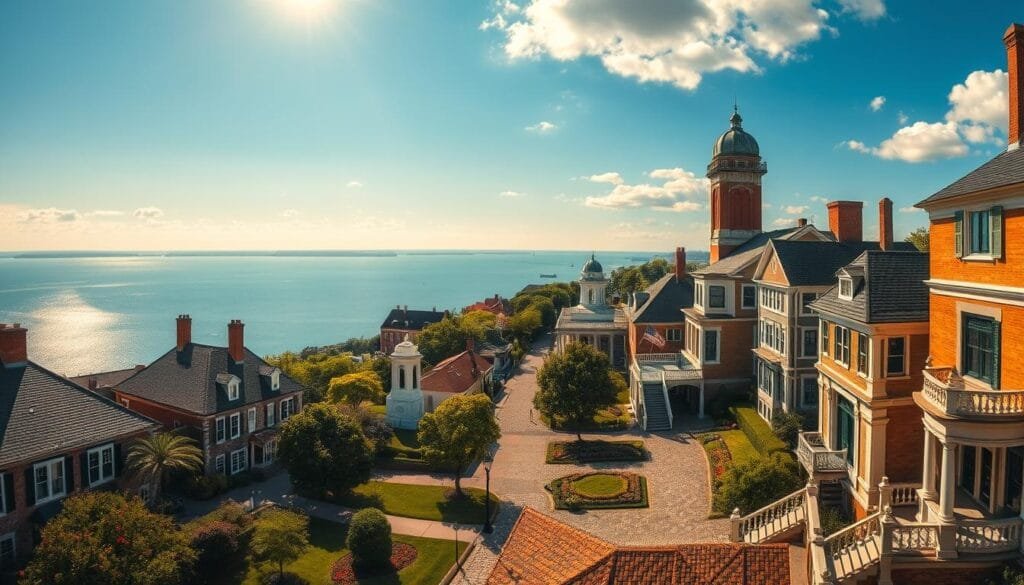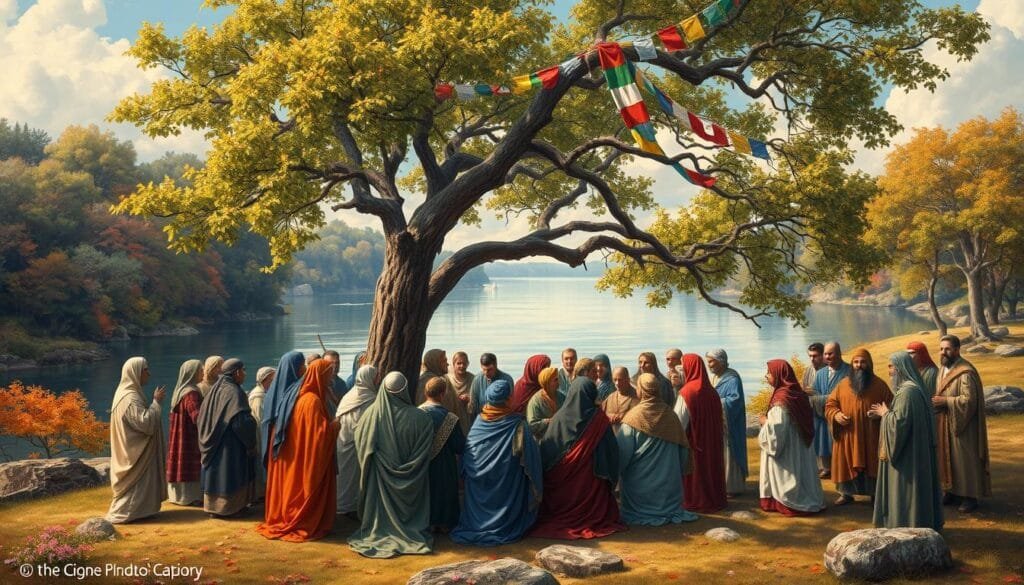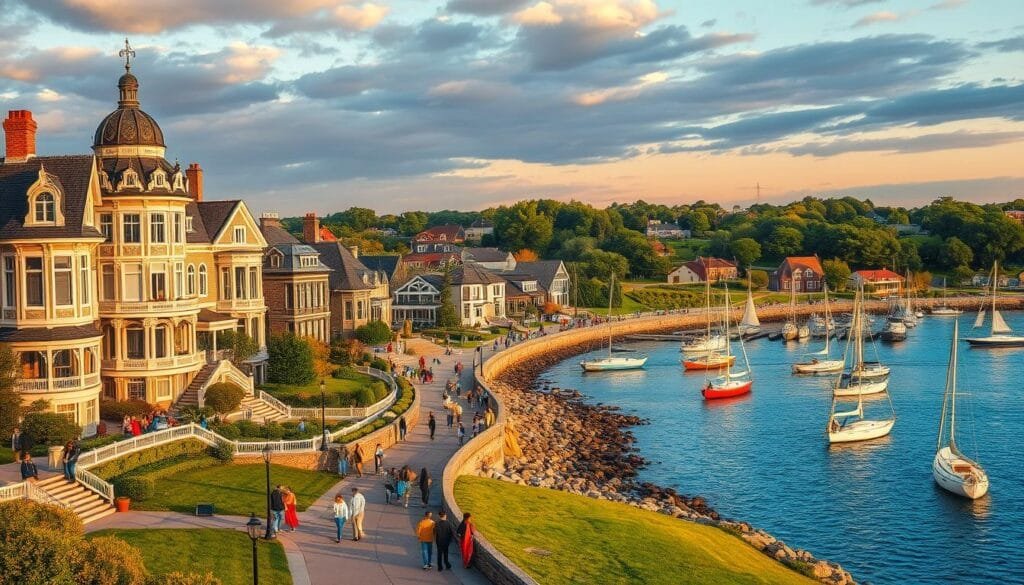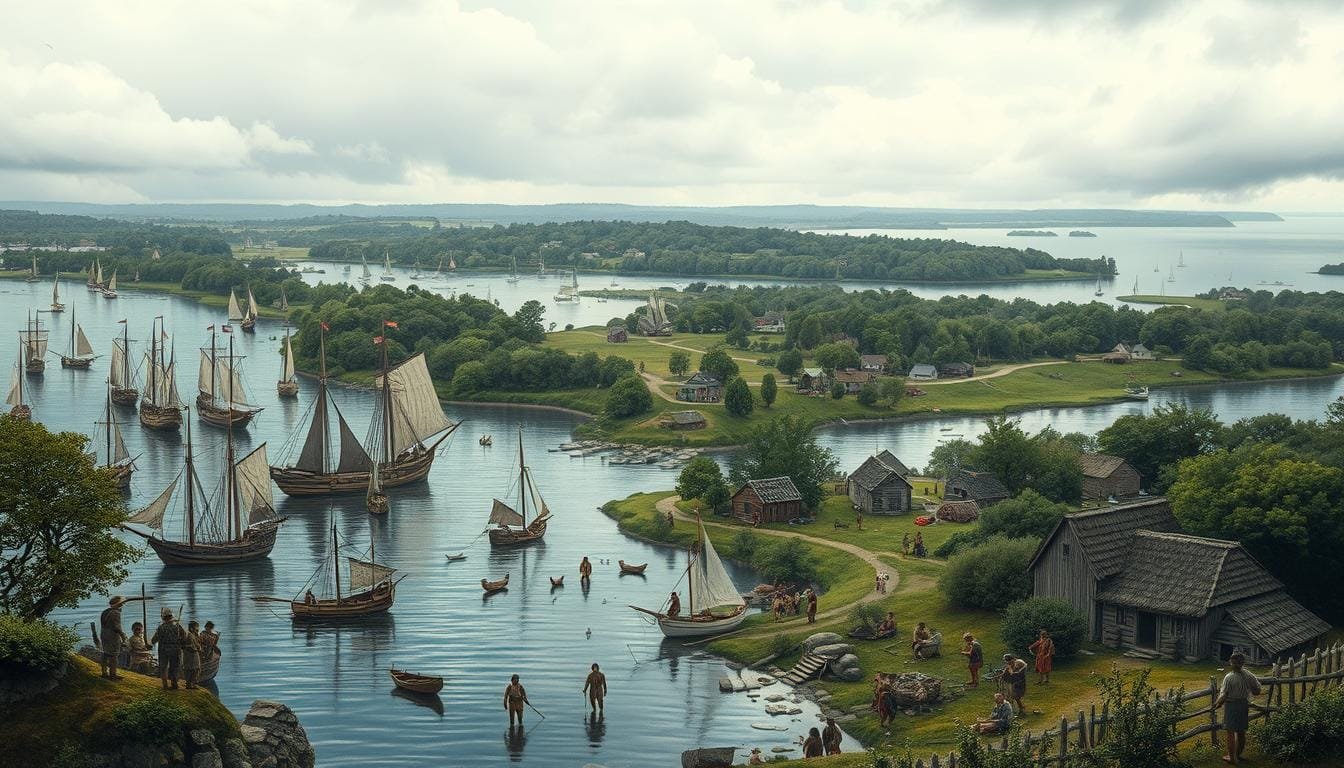Have you ever thought about the big impact the smallest state, Rhode Island, has on American history? It was founded by Roger Williams, who believed strongly in religious freedom. This belief shaped Rhode Island into a place rich in colonial culture and architectural heritage. Though small, just 48 miles long and 37 miles wide, Rhode Island’s historical importance is huge.
The Sakonnet River runs 14 miles from the Atlantic into Rhode Island, adding to its over 400 miles of coastline. This is why it’s called the “Ocean State.” It has a rich and diverse culture. Rhode Island was the first to say no to Great Britain in 1776. Its legacy lives on through cultural institutions and historic sites. Today, it blends history with modern-day energy. This is seen in its strong tourism industry and commitment to preserving history.
We will explore how Rhode Island’s history, from leading in the American Industrial Revolution to protecting its architectural heritage, defines its culture today. For a deeper look into Rhode Island’s culture, check out Britannica’s comprehensive guide.
Key Takeaways
- Rhode Island was founded on religious freedom principles by Roger Williams in 1636.
- Despite its size, the state has rich colonial culture.
- The Sakonnet River flows 14 miles from the Atlantic into Rhode Island.
- With over 400 miles of coastline, Rhode Island is rightly the “Ocean State”.
- It was the first colony to declare independence from Great Britain in 1776.
- Nowadays, Rhode Island celebrates a rich cultural heritage and a thriving tourism industry.
Historical Background of Rhode Island Colony
Rhode Island’s history is rich with tales of grit, community spirit, and a relentless pursuit of freedom. It all started with founding by Roger Williams in 1636. A true believer in religious freedom, Williams made Rhode Island a safe place for those escaping religious persecution.
At first, Rhode Island grew because of its strong relationships with the Native American tribes. Williams built friendly connections with tribes such as the Narragansett and the Wampanoag. These tribes were key in the early success and growth of the colony. They shared resources and knowledge with the settlers.
But then came King Philip’s War between 1675 and 1676. This conflict was named after Metacom, or King Philip, a leader of the Wampanoag. It destroyed many colonial settlements. The war changed the region forever. It damaged the relationship between the settlers and Native American tribes, causing a long-lasting impact.
Despite these challenges, Rhode Island’s settlers’ resilience allowed the colony to bounce back and thrive. By 1776, when Rhode Island opposed King George III, it was already known for its commitment to freedom and tolerance. Roger Williams’ founding principles and the enduring spirit of its people are key to understanding colonial Rhode Island.
Cultural Institutions and Architectural Heritage
Rhode Island’s cultural scene and architectural heritage are central to its history. The Redwood Library and Athenaeum in Newport stand out among the Notable Libraries and Museums. The Providence Athenaeum in the capital is also renowned. These places are known for their vast collections and unique architecture.
Museums are key in preserving Rhode Island’s history. The Rhode Island School of Design Museum boasts an extensive art collection. Meanwhile, the Museum of Work and Culture offers a glimpse into the state’s industrial heritage. These historical museums bridge the past to the present for all who visit.
Rhode Island is famous for its colonial architecture. The Governor Henry Lippitt House Museum showcases Victorian elegance, and the grand Newport mansions are breathtaking. The Breakers, a Vanderbilt home, has 70 rooms with stunning decorations. Marble House is another marvel, built with an immense amount of marble.

Places like Newport’s mansions reflect the Gilded Age’s wealth shifts. They reveal the lavish lifestyles of the Astors and Vanderbilts. These buildings attract everyone from history buffs to architecture enthusiasts and tourists.
| Architectural Location | Details |
|---|---|
| The Breakers | Features 70 rooms with opulent decorations. |
| Marble House | Constructed using 500,000 cubic feet of marble. |
| Governor Henry Lippitt House Museum | Displays Victorian architectural style. |
The Importance of Religion and Religious Freedom
The idea of Rhode Island religious freedom is key in U.S. history, thanks to Roger Williams. He founded Providence in 1636 after Massachusetts Bay Colony expelled him for his beliefs. Williams pushed for a society that cherished religious freedom and individual rights. His actions marked a sharp turn from the norms of his time, leading to the Royal Charter of 1663 by Charles II.
This Charter was a milestone for human rights, giving “full liberty in religious concernments.” It let people follow their religion without government interference. This made Rhode Island a leader in religious freedom. The Charter made sure no one was harassed for their beliefs if they kept the peace. This set up a legal system that protected religious diversity.

Roger Williams not only impacted Rhode Island. His principles started America’s First Amendment origins. They led to the separation of church and state in the U.S. Constitution and the Bill of Rights. His ideas inspired many and helped shape a society that values free thought and speech.
Rhode Island became a safe place for those facing religious persecution. It welcomed groups like Baptists, Quakers, and Jews. The first Baptist Church in America was founded in Providence in 1638. This showed Rhode Island’s commitment to being a place where diverse groups could live in peace. It was a real-life example of Williams’ vision, building a tolerant and diverse community.
The Royal Charter granted by Charles II in 1663 was a big step forward for human rights. It was the first time in history that individuals got the right to freely practice their religion.
Roger Williams’ work is often seen as a key starting point for the idea of separating church and state. His “lively experiment” in Rhode Island didn’t just affect local governance. It had a deep impact on the wider American values.
| Event | Year |
|---|---|
| Founding of Providence by Roger Williams | 1636 |
| Expulsion of Roger Williams from Massachusetts Bay Colony | 1635 |
| Parliamentary Patent uniting Providence, Portsmouth, and Newport | 1643 |
| Issuance of Royal Charter | 1663 |
| Establishment of First Baptist Church in America | 1638 |
| Charter serving as Rhode Island’s constitution | Until 1842 |
How Was the Culture in Rhode Island Colony?
Rhode Island’s culture from 1636 to 1642 focused on religious freedom and community closeness. The Wampanoag tribe helped Roger Williams start Providence in 1636. This start created a culture of tolerance and freedom. Quakers and Jews came in 1657 and 1658, adding to Rhode Island’s community life.
The economy largely depended on agriculture and fishing. But the introduction of textile mills, led by Samuel Slater, changed that. This change made the colony a leader in the industrial revolution.
But Rhode Island knew how to have fun too. Festivals were key, with parties, festivals, and balls, especially in Newport. Such events built a sense of community, making life vibrant.
Rhode Island was also ahead in social policies. It stopped witch trials and limited death penalties early on, in 1652. This showed its belief in fairness and humane rules.
In all, Rhode Island’s culture was a mix of different cultures and strong community bonds. Its economic success, festive events, and focus on justice made it stand out.
Impact of Industrialization and Transition to Tourism
The Role in the American Industrial Revolution changed Rhode Island a lot. It started with the country’s first textile mill by Samuel Slater. This made Rhode Island a key player in the Rhode Island Industrial Revolution. It significantly increased the state’s economic and political power until the early 20th century. The textile industry went down from the 1920s through the 1930s Great Depression. Yet, Rhode Island saw a brief manufacturing boom during World War II.
Rhode Island then smoothly turned into a top spot for American summer resorts. Newport is the best example of this change. By the late 19th and early 20th centuries, it became the gem of Newport tourism. In the Gilded Age, America’s wealthy built huge “cottages” along its scenic coast. This made Newport a symbol of luxury and fun.

But, tourism in Newport was more than just a local change. It was a big shift towards meeting the need for rest and cultural experiences. Newport’s beautiful nature and history keep drawing in tourists. This keeps Newport as a vital part of American summer resorts, from the Gilded Age to now. This shows Rhode Island’s great skill in adapting and staying important through time.
Conclusion
Rhode Island’s cultural legacy is key to American history. Its start by Roger Williams and making of Providence was crucial. This place believed in tolerance and religious freedom from the start. The first Baptist church is here, thanks to Williams. This spot was safe for Baptists, Quakers, and Jews. It was a community ahead of its time, valuing freedom.
Rhode Island had its share of issues too. It was tied to the global slave trade, having many enslaved people. Yet, it led the way by creating the first anti-slavery law in the Americas. This law marked a step towards freedom for all.
Rhode Island’s history is filled with both good and bad. Now, its historical sites draw people who love history. They come to see Rhode Island’s unique cultural story. This state played a big part in America’s quest for independence. Its spirit of self-rule and fight for freedom still inspire us today.
FAQ
What are some key aspects of Rhode Island’s history?
Rhode Island is the smallest state but has a big cultural heritage. It was started by Roger Williams on the idea of religious freedom. Williams also led in rebelling against colonial rule and starting new industries. The state’s story includes important events with the Narragansett and Wampanoag tribes.
Who founded Rhode Island and why?
Roger Williams founded Rhode Island in 1636. He wanted a place where people could freely practice their religion. This idea was new back then and later inspired America’s First Amendment.
How did Rhode Island’s interactions with Native American tribes influence its history?
At first, Rhode Island settlers and Native American tribes got along well, thanks to Roger Williams. But later, conflicts grew, leading to wars like King Philip’s War. These wars greatly affected the colony’s culture and history.
What are some significant cultural institutions in Rhode Island?
Libraries like the Redwood Library and the Providence Athenaeum are in Rhode Island. There are also museums, including the Rhode Island School of Design Museum. These places hold vast collections and link the state’s history with today.
How important is Rhode Island’s architectural heritage?
The architecture in Rhode Island is very important to its history. There are famous buildings like the Governor Henry Lippitt House Museum and Newport mansions. These buildings show off the state’s rich past.
Why is religious freedom particularly important in Rhode Island’s history?
Religious freedom is a key part of Rhode Island’s story, thanks to Roger Williams. This principle drew many different religious groups. It helped create a diverse and accepting community.
What was the culture like in colonial Rhode Island?
Colonial Rhode Island had a small-town atmosphere and a strong community spirit. People had varied jobs from farming to starting the textile industry. They also enjoyed many festivals, adding to a lively culture.
How did the Industrial Revolution affect Rhode Island?
The Industrial Revolution really changed Rhode Island when Samuel Slater built the first textile mill. The state became highly industrialized. After the industry’s decline, tourism grew, making places like Newport famous for its grand summer homes.
What is the cultural legacy of Rhode Island?
Rhode Island’s culture is marked by historic events, beautiful architecture, and the idea of religious freedom. This rich cultural heritage has made a big impact on America. Efforts to preserve it continue, drawing tourists and people interested in history.
